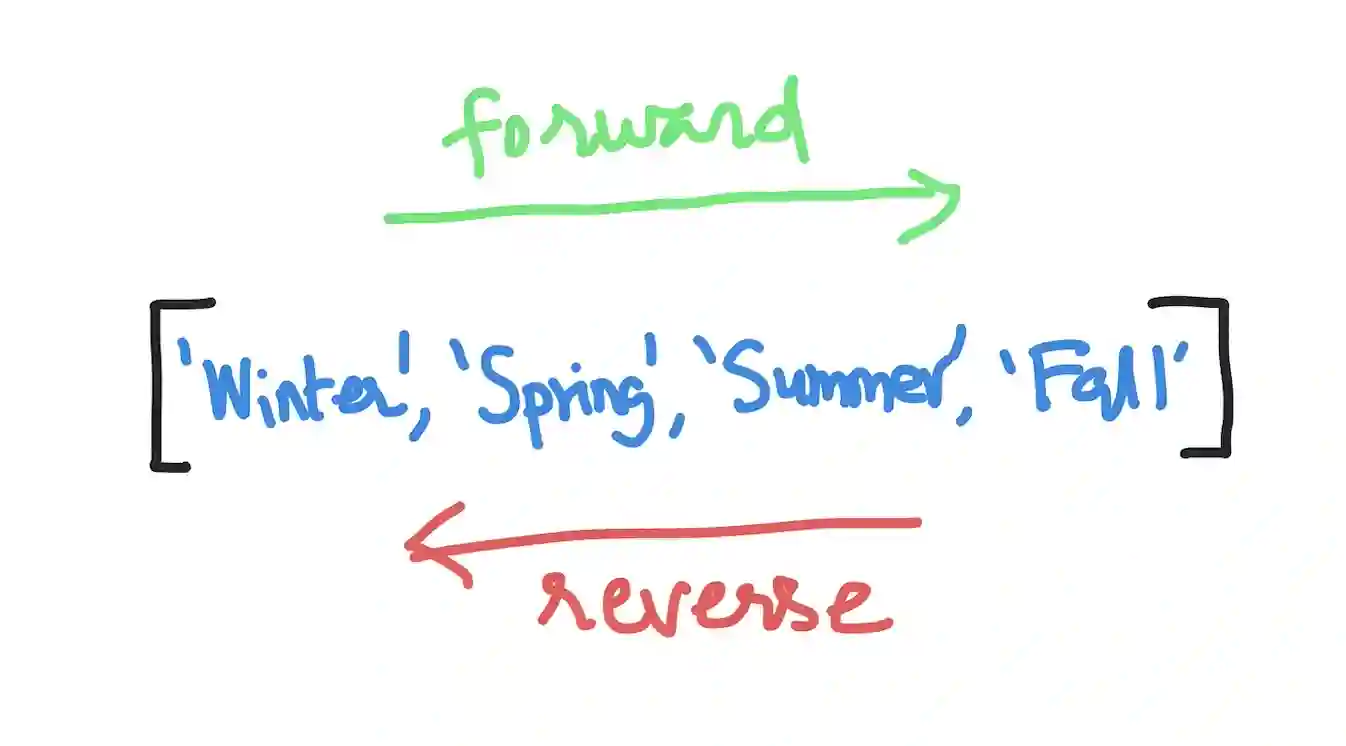Kodeclik Blog
Iterating over a Python list in reverse
When working with lists in Python, there are often situations where you need to process the elements in reverse order. Python provides several ways to iterate over a list in reverse, each with its advantages and use cases.
In this blog post, we will explore three effective methods to iterate over a list in reverse order using a list of seasons ['Winter','Spring','Summer','Fall'] as an example.

Method 1: Use a negative step size in a loop
The first method involves utilizing a negative step size in a loop to traverse the list in reverse. Python allows you to specify a negative value for the step in the range() function or a for loop, which effectively moves backward through the list. Let's see how this method works with the example list of seasons.
seasons = ['Winter', 'Spring', 'Summer', 'Fall']
for i in range(len(seasons) - 1, -1, -1):
print(seasons[i])In this code snippet, we start the loop from the last index of the list (len(seasons) - 1) and decrement the index by 1 with each iteration until we reach -1, which is the second argument in the range(). The negative step size (-1) ensures that the loop iterates in reverse, printing the seasons in the list in reverse order.
The output is:
Fall
Summer
Spring
WinterMethod 2: Use the reversed() function
The second method involves using the built-in reversed() function, which returns an iterator that traverses the elements of a sequence in reverse order. We can use a for loop or join() method to work with the iterator and print or manipulate the elements in reverse.
seasons = ['Winter', 'Spring', 'Summer', 'Fall']
reversed_seasons_list = list(reversed(seasons))
print(reversed_seasons_list)The reversed() function takes the list seasons as an argument and returns an iterator that goes through the elements in reverse order. We then convert the reversed iterator to a list reversed_seasons_list, which can be used later in the code.
The output is:
['Fall', 'Summer', 'Spring', 'Winter']Note that in this case we obtain a new list which we can then iterate over as desired.
Method 3: Use slicing operators
The third method involves using slicing operators to extract elements from the list in reverse order. We can specify a negative step in the slice to obtain the desired elements in reverse sequence.
seasons = ['Winter', 'Spring', 'Summer', 'Fall']
reversed_seasons = seasons[::-1]
print(reversed_seasons)In this method, we use the slicing operator [::-1] to extract all elements from the list seasons with a step of -1, resulting in the reversed list reversed_seasons. The output is:
['Fall', 'Summer', 'Spring', 'Winter']Which of these methods is your favorite? Each has its own advantages and disadvantages.
The negative step size method is straightforward and works well for iterating over small lists in reverse order. It does not require any additional functions, making it a simple and efficient solution for small-scale operations.
The reversed() function approach is easy to use and read, making the code more expressive. This method is suitable for cases where you need to work with the elements in reverse order but don't want to modify the original list.
Slicing offers a concise and elegant way to reverse the list without altering the original list. It is the most Pythonic way for reversing a list and works efficiently for large lists as well.
The techniques described here can be used for reversing a range since range operators can be viewed as returning a list as well and thus the underlying principles are the same. Also learn how to check if a given object is iterable, i.e., whether it can be iterated over by accessing its elements one by one.
Interested in more things Python? Checkout our post on Python queues. Also see our blogpost on Python's enumerate() capability. Also if you like Python+math content, see our blogpost on Magic Squares. Finally, master the Python print function!
Want to learn Python with us? Sign up for 1:1 or small group classes.